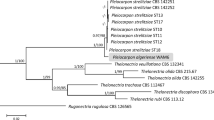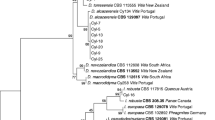Abstract
Species of Cylindrocladiella occur on a variety of hosts, where they are known to act as pathogens or saprobes. Eight species from this genus are currently recognised, of which five have been reported previously in South Africa: C. camelliae, C. elegans, C. lageniformis, C. parva and C. peruviana. Isolates of Cylindrocladiella were obtained from a newly established 99-Richter grapevine mother vine block exhibiting decline symptoms. The DNA phylogeny of these and additional isolates, also obtained from declining grapevines, was determined by sequencing the ITS (ITS 1, ITS2 and 5.8S) as well as (β-tubulin and histone H3 gene regions. This identified four species of Cylindrocladiella on grapevines in South Africa: C. lageniformis, C. parva, C. peruviana and a new species described here as C. viticola, which forms part of the C. infestans species complex. Pathogenicity trials, using stem inoculations on green and 1-year-old 99-Richter cuttings to determine the pathogenicity of selected isolates of these species, gave inconclusive results.
Similar content being viewed by others
References
Boesewinkel HJ (1982) Cylindrocladiella, a new genus to accommodate Cylindrocladium parvum and other small-spored species of Cylindrocladium. Canadian Journal of Botany 60, 2288–2294.
Crous PW (2002) ‘Taxonomy and pathology of Cylindrocladium (Calonectria) and allied genera.’ (APS Press: Minnesota)
Crous PW, Wingfield MJ (1993) A re-evaluation of Cylindrocladiella, and a comparison with morphological similar genera. Mycological Research 97, 433–448.
Crous PW, Wingfield MJ (1994) A monograph of Cylindrocladium, including anamorphs of Calonectria. Mycotaxon 51, 341–435.
Crous PW, Phillips AJL, Wingfield MJ (1992) Effects of cultural conditions on vesicle and conidium morphology in species of Cylindrocladium and Cylindrocladiella. Mycologia 84, 497–504.
Crous PW, Wingfield MJ, Lennox CL (1994) A comparison of generic concepts in Calonectria and Nectria with anamorphs in Cylindrocladium and Cylindrocladiella. South African Journal of Science 90, 485–188.
Crous PW, Groenewald JZ, Risede J-M, Hywel-Jones NL (2004) Calonectria species and their Cylindrocladium anamorphs: species with sphaeropedunculate vesicles. Studies in Mycology 50, 415–130.
Farris JS, Kallersjo M, Kluge AG, Bult C (1994) Testing significance of incongruence. Cladistics 10, 315–320. doi; 10.1111/j.1096-0031.1994.tb00181.x
Fisher NL, Burgess LW, Toussoun TA, Nelson PE (1982) Carnation leaves as a substrate and for preserving cultures of Fusarium species. Phy topathology 11, 151–153.
Glass NL, Donaldson GC (1995) Development of primer sets designed for use with the PCR to amplify conserved genes from filamentous ascomycetes. Applied and Environmental Microbiology 61, 1323–1330.
Hillis DM, Bull JJ (1993) An empirical test of bootstrapping as a method for assessing confidence in phylogenetic analysis. Systematic Biology 42, 182–192.
John JA, Quenouille MH (1977) ‘Design and analysis’. (The Garden City Press Ltd: Letchworth, UK)
Kang JC, Crous PW, Schoch CL (2001) Species concepts in the Cylindrocladium floridanum and Cy. spathiphylli complexes (Hypocreaceae) based on multi-allelic sequence data, sexual compatibility and morphology. Systematic and Applied Microbiology 24, 206–217. doi: 10.1078/0723-2020-00026
Lee SB, Taylor JW (1990) Isolation of DNA from fungal mycelia and single spores. In ‘PCR protocols: a guide to methods and applications’. (Eds MA Innis, DH Gelfand, JJ Sninsky, TJ White) pp. 282–287. (Academic Press: New York)
Levene H (1960) Robust test in the equality of variance. In ‘Contributions to probability and statistics’. (Ed. IP Alto) pp. 278–292. (University Press: Stanford, CA)
Mandal NC, Dasgupta MK (1983) Postharvest diseases of perishables in West Bengal 1: new host records and a new fungus from India. Indian Journal of Mycology and Plant Pathology 13, 73–77.
O’Donnell K, Cigelnik E (1997) Two divergent intragenomic rDNA ITS2 types within a monophyletic lineage of the fungus Fusarium are nonorthologous. Molecular Phylogenetics and Evolution 7, 103–116. doi: 10.1006/mpev.l996.0376
Page RDM (1996) TREEVIEW: an application to display phylogenetic trees on personal computers. Computer Applications in the Biosciences 12, 357–358.
Peerally A (1991) The classification and phytopathology of Cylindrocladium species. Mycotaxon 40, 323–366.
Rambaut A (2002) ‘Sequence alignment editor. Version 2.0’. (Department of Zoology, University of Oxford, Oxford)
Rayner RW (1970) ‘A mycological colour chart.’ (Commonwealth Mycological Institute: UK)
Rossman AY (1979) A preliminary account of the taxa described in Calonectria. Mycotaxon 8, 485–558.
SAS Institute Inc. (1999) ‘SAS/STAT user’s guide, version 8, 1st printing, vol. 2.’ (SAS Institute Inc.: Cary, North Carolina)
Schoch CL, Crous PW, Wingfield MJ, Wingfield BD (2000) Phylogeny of Calonectria and selected hypocrealean genera with cylindrical macroconidia. In ‘Molecules, morphology and classification: towards monophyletic genera in the Ascomycetes’. (Eds KA Seifert, W Gams, PW Crous, GJ Samuels). Studies in Mycology 45, 45–62.
Shapiro SS, Wilk MB (1965) An analysis of variance test for normality (complete samples). Biometrika 52, 591–611.
Sharma JK, Mohanan C (1991) In vitro evaluation of fungicides against Cylindrocladium spp. causing diseases of Eucalyptus in Kerala, India. European Journal of Forest Pathology 21, 17–26.
Snedecor GW, Cochran WG (1989) ‘Statistical methods’. 8th Edition. (Iowa State University Press: Iowa)
Swofford DL (2000) PAUP. ‘Phylogenetic analysis using parsimony (and other methods) version 4.’ (Sinauer Associates: Sunderland, Massachusetts)
Victor D, Crous PW, Janse BJH, Van Zyl WH, Wingfield MJ, Alfenas AC (1998) Systematic appraisal of species complexes within Cylindrocladiella. Mycological Research 102, 273–279.
White TJ, Bruns TD, Lee S, Taylor JW (1990) Amplification and direct sequencing of fungal ribosomal RNA genes forphylogenetics. In: ‘PCR protocols: a guide to methods and applications’. (Eds MA Innis, DH Gelfand, JJ Sninsky, TJ White) pp. 315–322 (Academic Press: New York)
Author information
Authors and Affiliations
Corresponding author
Rights and permissions
About this article
Cite this article
van Coller, G.J., Denman, S., Groenewald, J.Z. et al. Characterisation and pathogenicity of Cylindrocladiella spp. associated with root and cutting rot symptoms of grapevines in nurseries. Australasian Plant Pathology 34, 489–498 (2005). https://doi.org/10.1071/AP05058
Received:
Accepted:
Issue Date:
DOI: https://doi.org/10.1071/AP05058




